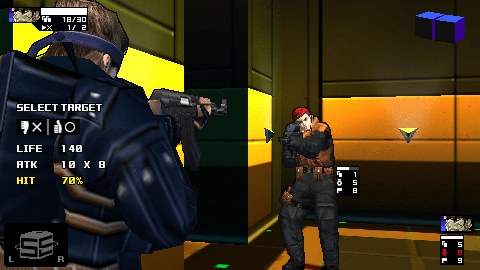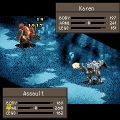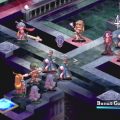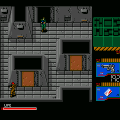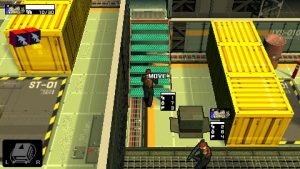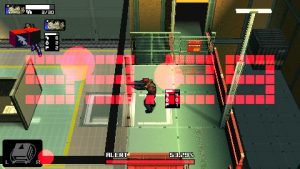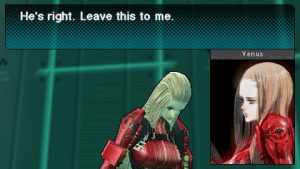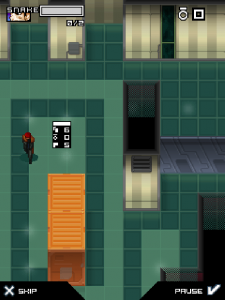- Metal Gear
- Snake’s Revenge
- Metal Gear 2: Solid Snake
- Metal Gear Solid
- Metal Gear Solid Integral Staff Commentary
- Metal Gear Solid (Game Boy Color)
- Metal Gear Solid 2: Sons of Liberty
- Document of Metal Gear Solid 2, The
- Metal Gear Solid: The Twin Snakes
- Metal Gear Solid 3: Snake Eater
- Metal Gear Solid 4: Guns of the Patriots
- Metal Gear Solid: Portable Ops
- Metal Gear Solid: Peace Walker
- Metal Gear Solid V: Ground Zeroes
- Metal Gear Solid V: The Phantom Pain
- Metal Gear Rising: Revengeance
- Metal Gear Touch
- Metal Gear Acid
- Metal Gear Acid 2
- Metal Gear Solid Mobile
In a welcome surprise, Snake’s card battling experiment wasn’t just a one off event. The team followed up with a new game a year later, expanding expanding and adding more. It differentiates itself with a new cell-shaded style, expands upon the eclectic mix of trading cards and turn-based strategy, and it features a unique, if impractical accessory to give the game a more ‘solid’ look. The more well-rounded offering of Acid 2 improves upon the original, and helps highlight what works, while also making Acid‘s deficiencies more obvious too.
Mystery marks the story in Acid 2. It opens with Snake working with a band of other mercenaries who rescued him. A first for the legendary soldier, Snake has amnesia. Other than his soldering skills, he’s forgotten who he is and what he was doing before his mercenary friends found him. They are on route to the US when their plane is detained, and Snake is forced into a mission by Dalton, an FBI agent, in order to clear his name and that of his friends. He is tasked with covertly sneaking into military manufacturer SaintLogic in the fictional South American nation of Serena and discover what they’re up to (spoilers: it’s a Metal Gear). His companion character out on the field this time is Venus, another mercenary with a ice-cold attitude and her own mysterious background. An unseen character in other spin offs like Ghost Babel and the Snake Tales side-stories in MGS 2: Substance, Dr. Kopplethron, shows up for the first time in a pivotal role. Snake has to unravel the mysteries around him, including himself, as the game goes on.
Acid 2 iterates on the card shuffling, turn-based stealth action of the first one. A clearer tutorial helps on-board players quicker to some of the more esoteric concepts of the game. The UI is cleaner and more readable than the first one. Turns move peppier, and the cards are dolled out with a bit more reliability than the first one. For players with a save file from the original game, you can import one card and the currency for card buying into the sequel. The second player character, Venus is faster and can do more in a turn, but is easier to knock down and has less health, much like Teliko in the first title. The camera is still a problem, resting too tightly on the action. Without a feature that outlines characters behind parts of the stage or that lower the opacity on foreground elements, it’s easy to get lost as players try to get a lay of the land and make strategic decisions, something more apparent in this more visually busy sequel. Arena Mode pits players up against the likes of Fortune, Liquid Snake, and other bosses in the series, in a fast paced set of turn-based combat. The mode is barebones and a touch easy, but is a welcomed bonus for those wanting more stealthy card strategy or to grind for more cards. The multiplayer mode found in the first one returns with a small variation. Instead of snatching disks and finding the exit, players compete to destroy orbs.
The original Acid, despite its unique gameplay, captured the gritty, military look that the series is usually known for – industrial wall textures, boxy structures, a restrained color palette. Acid 2 moves away from that, being an brighter and more stylish game. Tutorials take place on clear white VR stages, full of structures splattered with a mish-mash of textures, which is certainly a choice. A dash of cell shading is used to give the game a comic book/manga look, especially in comparison to the rest of the series. For as bright as the game looks, voice acting is once again absent. It stings too, give how much the performances in all sorts of languages helped define the series’ appeal. The three composers from the first game, Nobuko Toda, Shuichi Kobori, and Akihiro Honda, return to produce music for the game, joined by Hiroshi Tanabe. The result is much like the first game, an punchy, dynamic score to the strategic gameplay.
The Solid Eye feature is an interesting addition. Using a piece of cardboard with two eye hole cutouts, the PSP duplicates the image and allowed players to view the game with a more ‘solid’ look to it. Exclusive stereoscopic videos, many that are cutscenes from MGS3, are unlocked by collecting cards during gameplay, and connecting the PSP to a PS2 running Metal Gear Solid 3: Subsistience allowed players to transfer photos taken in that game and display them as 3D images on the PSP’s screen, a neat little treat for the snap-happy gamer. The name “Solid Eye” is reused for the stylish AR eye patch Old Snake wears in MGS4.
Like the original game, Acid 2 got a mobile phone adaptation in 2008, exclusive to European markets from Glu Mobile once again. Coming in both polygonal and sprite variations, this port cuts a lot more than the port of the first game and makes more modifications, like a more simplified and less effective tutorial. Still, it works well as a mobile game, the turn-based nature makes it a natural fit for the keypads of feature phones, and it’s a decent way to experience it.
For a series that has been around as long as Metal Gear, experiments are fun to see, especially when they take unique chances in the gameplay department. Acid 2 improves upon the original, but it wasn’t a success financially. Of course, it wouldn’t be the last that the PlayStation Portable would see of the series, with Portable Ops along with the much more expansive Peace Walker. The PSP ended up having more Metal Gear games than the PS3, perhaps a testament to the way the game industry developed. Experimental spin offs dried up by the time the PS4 was released, as the cost of development rose as did the time and human effort to make them. The Acid series exemplifies a different time in the industry that many older gamers have nostalgia for, where creators who were at the forefront of interactive entertainment could afford to try different things and make some mistakes.
Screenshot Comparisons



